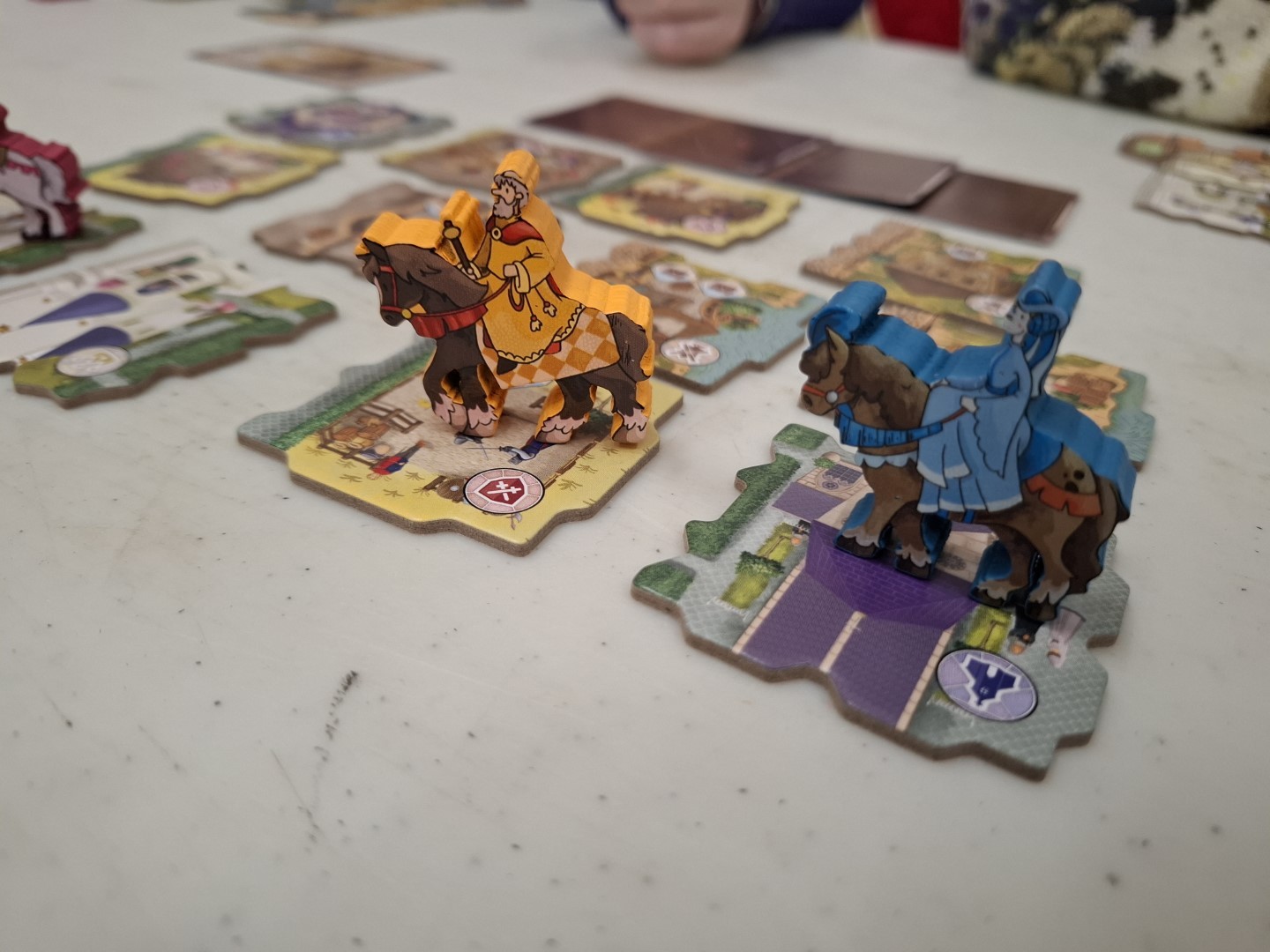So in summary Middle Ages is almost perfect. Go play it!

Okay, I should probably give you a little bit more as to why I think Middle Ages is almost perfect. Middle Ages is a game for 2 to 5 players that takes place over 16 rounds. Now the game says you’ll explore the economics of the Middle Ages, that’s maybe a tenuous link, or maybe it’s a fair description. After all, it’s all about being the richest.
In Middle Ages, each player has their own fiefdom that they’ll be adding tiles to and potentially removing some too! The game centres around a main display of tiles that will see players take and place tiles over 16 rounds.

How to play
On your turn, you’ll move your lord to a tile in the next row and then place the tile your lord left in your Fiefdom in the matching estate. You’ll then activate the special effect of that tile and then activate the income ability of that tile. After everyone has moved their lord, you’ll refill the row the lords just moved from and sort the tiles in ascending order. At the end of every 4th round, you’ll resolve an event card, which can be a mixture of getting more coins or sadly losing stuff like coins and even tiles.
The special abilities of the tiles are a mixture of;
- get more money,
- take money from other players, destroy tiles in other players’ fiefdoms, place a previously destroyed tile
- reserve a future tile
- increase the income ability of a tile
For example, the Mills will see you other players pay you 2 coins if they have fewer mills than you. While the ramparts allow you to place your scout on a tile on a future row, which can give you added scope to plan how you’ll place your lord over the next round or two.

There is an element of take that here, in that you will take other player’s stuff, and there’s not a whole lot they can do about it in the moment. But they can prepare and look to protect themselves. And if you ignore the tiles that can protect you, then you’ve left yourself open to those moments. Importantly, Middle Ages forces you to consider everything as you’ll lose 10 coins for each estate you don’t have a tile of.
And I think this is the balance of Middle Ages that shines through. You can go all in on one or two types of estates. But you’ll leave yourself open to take that moments and you’ll find yourself losing points at the end of the game. So, although you may focus on one specific estate and feel like you’re bringing in the big bucks, you’ll find yourself restrained by the games balancing.

Initial Thoughts
I’ve played Middle Ages 9 times at this point, and I’m already craving more plays. There’s a satisfaction that comes from building a tableau that always gets you stuff. And there’s an ease to teaching here that means I’ve managed to teach Middle Ages to new players in a minute or so, adding in a few clarifications as the rounds progress. Which makes it almost perfect for the game night bag.
However, Middle Ages isn’t quite perfect. I’ve talked about above its balancing that can intentionally restrain you and prevent you from going all in on one estate. But, due to the nature of tile draw, you can find yourself facing back to back turns just taking the same tile. Now, this doesn’t happen every game, and maybe it’s only a few rounds a game.

But when the following rows may have 1 or 2 different tiles just due to the way the tiles came out, it can feel like there’s no real decision making. And there’s no rule regarding a redraw if you draw tiles with the same numbers. When it feels like maybe there could be. Now it’s not a big deal, but it can feel a little bit grating
For all its greatness in its components, from the quality of the artwork and the tiles and player pieces. There is one thing missing, a player aid to explain all the abilities and income. It is explained in the centre of the rulebook, and you can leave that open on the table. It just isn’t very practical. But a player aid or two would have been a big help. Yes, I could print one out myself, but Aaron doesn’t have a printer.
As you know, I rate games on a scale of:
Buy or play
Wait for sale or play if you like game XYZ
Avoid

Conclusion
Middle Ages gets a firm Buy or Play recommendation, there’s enough here for this game to fit into anyone’s collection and despite its minor flaws (or at least I’d call them minor) it offers a rewarding experience for both new board gamers and long time gamers. I would just recommend you print out a player aid or two.
There are some flaws here in terms of the luck of the draw, and you can find yourself almost boxed in at times. However, the satisfaction in taking hands full of money from the bank or at times over players often outweighs this. I can’t wait to play Middle Ages again, and its a game that has found a permanent home in my collection.

Want to buy Middle ages, you can from Kienda: https://kienda.co.uk/home/5153-middle-ages-3616450013803.html

